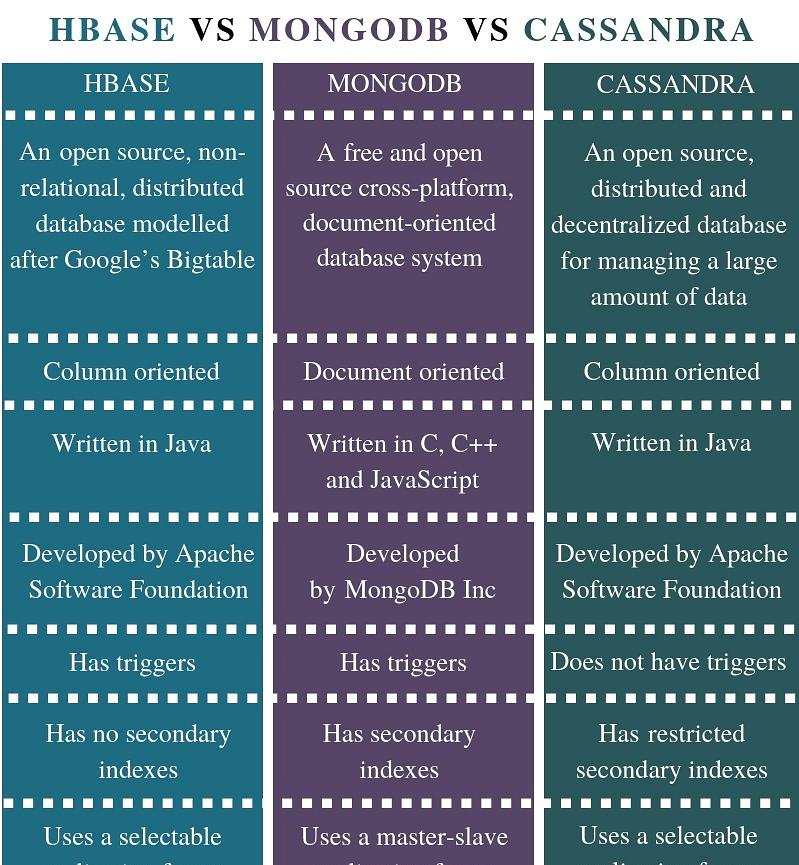What is the Difference Between HBase and MongoDB and Cassandra? with Proper Definition and Brief Explanation
The main difference between HBase and MongoDB and Cassandra is that the HBase and Cassandra are column-oriented databases while MongoDB is a document-oriented database.
Big data refers to a large amount of data. It has three main properties: volume, speed and variety. Volume refers to the amount of data, while speed refers to the speed of data generation, and variety refers to the type of data. The usual relational databases are not effective in storing this huge amount of data. Non-relational databases are the solution to this problem. They are also called NoSQL databases. HBase, MongoDB and Cassandra are three NoSQL databases. These databases allow users to store a large amount of data and access it randomly.
Key Areas Covered
1. What is HBase?
– Definition, Functionality
2. What is MongoDB?
– Definition, Functionality
3. What is Cassandra?
– Definition, Functionality
4. What are the similarities between HBase and MongoDB and Cassandra?
– Scheme of common features
5. What is the difference between HBase and MongoDB and Cassandra?
– Comparison of key differences
Key terms
HBase, MongoDB, Cassandra

What is HBase?
HBase, built on top of the Hadoop file system, is a distributed column-oriented database file system. It is an open source project. The purpose of HBase’s design is to gain random access to a large amount of structured data quickly. It sits on top of the Hadoop file system and provides read and write access.
Also, HBase is column-oriented. The rows are used to order the tables. A table in HBase is a collection of rows. A row is a collection of column families, while a column family is a set of columns. A column is a set of key-value pairs. So this is the storage mechanism in HBase.
Additionally, HBase provides a number of features. It is linearly scalable and provides automatic failover support. Provides data replication across groups. Plus, it integrates with Hadoop. In addition, the user can use HBase to perform random read and write operations to access big data and host large tables on commodity hardware.
What is MongoDB
MongoDB is a cross-platform, document-oriented database. It stores the data in the form of a JSON-style document. In MongoDB, a document is a set of key-value pairs, while a collection is a set of documents. It is similar to an RDBMS table. Also, the documents within the collection have multiple fields.

In MongoDB, each collection contains multiple documents. The number of fields, the content and the size of the document may vary from one document to another. Therefore, it is schema-less. There are no complex joins like in relational databases. Document-based query language helps execute dynamic queries against the database. An important factor when working with relational databases is that you need to convert or map application objects to database objects in order to store them in the database. But MongoDB doesn’t require that conversion. Also, it uses internal memory to store working sets. Therefore, it has faster data access capabilities.
What is Cassandra
Cassandra is an open source, distributed, decentralized database for big data. Provides highly available services without a single point of failure. Organizations like Cisco, Facebook, Twitter, and Netflix use Cassandra.
There are multiple advantages to using Cassandra. More hardware can be added to support more clients and data. Therefore, it provides scalability. Additionally, it is fault tolerant and continuously available for business-critical applications. It can also write terabytes of data faster. Since Cassandra supports big data, it is possible to store structured, semi-structured and unstructured data. Also, the user can distribute data across multiple data centers.
Similarities
- HBase, MongoDB, and Cassandra are schema-free.
- They all use the same partitioning method.
- They are reliable and provide high performance.
- In addition, they support the concurrence.
Differences
Definition
HBase is an open source, non-relational, distributed database modeled after Google’s Bigtable, while MongoDB is a free, open source, cross-platform, open source database system. Meanwhile, Cassandra is an open source, distributed and decentralized database for managing a large amount of data. This is the basic difference between them.
Database type
Another difference between them is that HBase and Cassandra are column oriented while MongoDB is document oriented.
Idiom
HBase is written in Java, while MongoDB is written in C, C++, and JavaScript, and Cassandra is written in Java. This is a big difference between them.
Developer
Apache Software Foundation developed HBase and Cassandra, while MongoDB Inc. developed MongoDB.
Triggers
One more difference between them is that HBase and Cassandra have triggers, but MongoDB does not have triggers.
Secondary indexes
Also, HBase has no secondary indexes, while MongoDB has secondary indexes and Cassandra has restricted secondary indexes.
Replication method
Also, HBase and Cassandra use a selectable replication factor while MongoDB uses a master-slave replication factor.
Conclusion
HBase, MongoDB and Cassandra are three NoSQL or non-relational database systems. HBase and Cassandra are column-oriented databases, while MongoDB is a document-oriented database. That is the difference between them. They are used for various applications such as Big Data, Content Management, mobile and social infrastructure, and data centers.
Courtesy image:
1. “MongoDB-Logo-5c3a7405a85675366beb3a5ec4c032348c390b3f142f5e6dddf1d78e2df5cb5c” By Alexander Sosluev – Own work (CC BY-SA 4.0) via Commons Wikimedia
2. “Cassandra Logo” By Apache Software Foundation (Apache Wikimedia License)